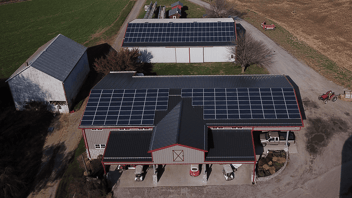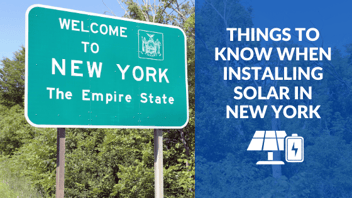8 Things To Know Before Installing Solar Panels in Ohio

“Find it here.”
This promise is spread across the sign greeting those entering the Buckeye State. While our state does have a lot to offer, electricity generated by pure sunshine probably isn’t on the top of your list.
Ohio’s climate is far from that of the solar hotspots in the southwest—especially in Northeast Ohio. If I had a nickel for every time someone mentioned the Ravenna Arsenal to me and why it was built there, I could probably retire early.
Despite this, solar panels can work in Ohio. They’ve helped homeowners, businesses, and farmers save money with emissions-free electricity, and I’m one of them. I've had a solar panel system on my home for over five years, and over eight years ago, I began helping others in Ohio make the switch to solar.
Going solar in Ohio will be different from going solar in other states. You’ll need to understand the rules and guidelines unique to Ohio before you decide to install a solar system. Luckily, I’m here to help you do just that.
- How Much Do Solar Panels Cost?
- Can You Use Tax Incentives to Go Solar?
- What Happens if My Solar System Overproduces?
- Will You Still Have an Electricity Bill?
- Connecting to the Grid
- How Much Power Can You Produce?
- Does Your Utility Require Proof of Insurance?
- Partner With the Right Installer
Here are 8 things you need to consider when installing solar panels in Ohio.
1. How Much Do Solar Panels Cost in Ohio?
The total cost of solar panels in Ohio depends on several factors, including your solar system’s size. Overall, you can expect to pay around $25,000 for a small residential system (about 5 kW) to $150,000 or more for a large commercial system.
These prices reflect solar panel installation costs after applying widely-available incentives available in the state.
Another key figure to estimate is how much solar will save you. Over the system’s lifespan, savings can range from $10,000 for a small residential system to upwards of $300,000 for a large commercial system.
2. Can You Use Tax Incentives to Go Solar in Ohio?
Yes, you can use tax incentives to make installing a solar energy system in Ohio more affordable.
Currently, there is a 30% Federal Income Tax credit and an additional 10% adder available for commercial and residential solar installations. Farms and businesses can also take advantage of bonus depreciation, which returns a significant portion of your investment.
Be sure to speak with your accountant to verify that you can take advantage of the solar incentives.
3. What Happens if My Solar System Overproduces in OH?
Solar systems typically generate extra electricity that can be used at night or when cloudy weather rolls in. This extra energy can be transferred to the utility grid for “storage” for grid-tied solar systems. Your utility will compensate you with a credit reflecting this transferred electricity. However, in Ohio, the amount your utility compensates you for this varies between utility companies.
The most beneficial compensation for solar owners is net metering, where solar power is compensated at the retail rate. For every kilowatt-hour (kWh) your solar system transfers to the grid, you can pull a kWh from the grid for no cost. Essentially, it’s a one-for-one trade: your energy for theirs.
However, some utilities in Ohio use what’s called net billing. This is when your excess energy is “sold” to the utility at the lesser wholesale rates—the cost they’d pay power plants and other producers for the electricity they generate.
4. Will You Still Have an Electricity Bill?
The short answer is yes, you’ll still have an electricity bill if you go solar, but it should be a lot less.
For many, it’s possible to produce 100% or more of the electricity needed with just solar. However, utilities have fixed charges for each meter regardless of how much electricity is used. So as long as you are connected to the utility grid, you will receive a monthly statement.
Demand-related charges on non-residential services will also remain; it is highly unlikely that your solar system will provide any cost savings to these charges.
Make sure you understand your utility’s net metering rules and how your monthly production and usage will impact your return on investment. Ask for a monthly output versus usage report that can help you better understand what your bills may look like.
Competitive Retail Electric Service or CRES Providers typically will not provide credit for net excess generation. It may be good to return to your local utility for your bill's supply or generation portion to fully benefit from net metering or net billing.
5. Connecting to the Grid
Make sure your solar contractor understands your utility’s process for grid connection approval before construction starts.
In Ohio, requirements for disconnects and other monitoring equipment can and do vary between utility companies. If your contractor installs your system before getting this approval, you will have a frustrating experience. This is especially true if additional equipment and/or changes are needed.
Ohio utilities provide an invaluable service that most of us don’t think about until the power goes out. The safe operation of your solar system is vital to the safety of linemen repairing service after an outage.
6. How Much Power Can You Produce?
Ohio may not have a plethora of bright, sunny days, but it gets enough to make solar viable. While your system’s production is limited by how much energy you receive, several other factors impact production.
Panels’ tilt, orientation to the sun, shading, and more all impact solar panel production. The type of solar panel you install also affects how much energy you produce. A well-designed solar system can produce a significant amount of electricity in Ohio.
However, there is a limit on just how much power you’re allowed to produce. The latest ruling from the PUCO is that a renewable energy system can produce up to 120% of a customer’s energy usage.
Most utilities will limit over-producing systems unless they prove their annual usage will increase after the system is installed. This could be for reasons like adding an electric car or installing a new piece of manufacturing equipment.
Find out how your utility handles annual excess energy if you plan to push those limits, and be sure you understand it.
7. Does Your Utility Require Proof of Insurance?
Most, not all, of the utilities require proof of liability insurance before approving your interconnection. Speak to your insurance agent and understand any additional cost to your premium to protect this investment and comply with utility requirements.
If a separate insurance policy is needed, the cost should be factored into the system’s investment projections given to you in your solar proposals.
8. Partner With The Right Solar Installer
Solar energy is a long-term investment. It's critical to select a solar energy installer in Ohio who has experience with local utilities and will stand behind their workmanship. We put together a list of questions to ask yourself when evaluating a solar installer. Use these to guide your selection process.
At Paradise Energy Solutions, our 1,600+ clients are like family, and our commitment to them is a long-term one. We are committed to being your honest, upfront partner for the life of your system. Check out our reviews for an inside look at what it's like to partner with us.
Are you ready to learn more about solar installation in Ohio? Schedule a site visit with one of our solar consultants. If you're not ready just yet, spend more time browsing our educational blog posts or exploring our solar buying guide.
Originally posted on May 27, 2020. Updated on June 3, 2022.





